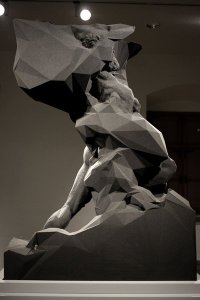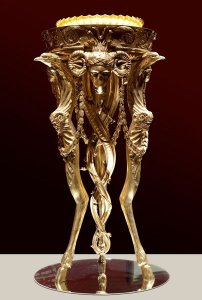The idea that museums – keepers of our history – might want to embrace the technology of the future is not radical in itself. But some technologies have particularly complex implications, and 3D printing is one of them. The use of 3D printing in, and in response to, museums and art galleries raises a host of issues: in short, the capacity of this technology to mimic and reproduce at speed has major implications for copyright and for artistic authenticity and originality.
However, more and more museums are proving that 3D printing can be an effective medium for interpreting and disseminating their collections, with BOZAR, Brussels, even dedicating an exhibition to the topic. ‘Making a Difference/A Difference in Making’ – which opens this week – explores the crossings-over between art and technology, showing cutting-edge 3D printed design alongside the latest in engineering and scientific applications for the process.

Captives #B06 (2014) Davide Quayola © the artist
Recently, various museums have entered into collaboration with artists who incorporate digital technology into their practice, provoking questions about the artistic value of printed artefacts. Pushing the boundaries of both curatorial practice and public expectations, this embrace – which has been more enthusiastic in some institutions than in others – has brought in the work of contemporary artists who might not have found a platform for their work in more traditional museums in the past. Both the institutions and the artists benefit from these arrangements, with the latter having access to a collection that functions as both resource and inspiration, and the former gaining a new, refreshing perspective on that collection.
One artist working in this vein is Davide Quayola, who has produced monumental printed articulations of Michelangelo’s Captive Slaves on display in the Accademia, Florence. Some of these are direct copies of the original, others interpret the sculptures as a series of geometric planes, provoking questions about the texture and unfinished nature of these works. At the Victoria and Albert Museum, recent artists in residence The T Shirt Issue produced a series of geometric models of objects in the collection, based on 3D scans, which influenced their work in pattern and garment design. Most daringly, Sir John Soane’s Museum pushed the boundaries of what constitutes a displayable object with their 2014 exhibition ‘Diverse Maniere: Piranesi, Fantasy and Excess’, in which many of Piranesi’s most elaborate designs were finally realised via 3D printing.

Helix Tripod (2010), a Factum Arte performance of a design of Giambattista Piranesi. Photo: Factum Arte and Fondazione Giorgio Cini Onlus
3D printed objects can be seen as contemporary counterparts to the great plaster cast collections of the 19th century, fulfilling many of the same functions: dissemination, preservation and material experimentation. Their potential is much greater, however. They go beyond the simple copying of artworks: the Piranesi show, for example, offered a valuable insight into the great designer’s work by enabling a reconstruction that, previously, would have been almost impossible. 3D printing could also have positive implications for conservation and education, making and reconstructing objects for experimentation without damaging the originals. Such pieces will surely form a significant role in the museums of the future.
‘Making a difference / A difference in making’ is at BOZAR, Brussels, from 24 April–7 June.
Related Articles
‘Diverse Maniere: Piranesi, Fantasy and Excess’ at Sir John Soane’s Museum
Digital Innovation of the Year: Factum Arte
Printing Press: have artists woken up to the potential of 3D printing?
More than just copies: Brussels’ Plaster Cast Workshop

Museums have finally woken up to the potential of 3D printing
Captives #1 (2013), Davide Quayola © the artist
Share
The idea that museums – keepers of our history – might want to embrace the technology of the future is not radical in itself. But some technologies have particularly complex implications, and 3D printing is one of them. The use of 3D printing in, and in response to, museums and art galleries raises a host of issues: in short, the capacity of this technology to mimic and reproduce at speed has major implications for copyright and for artistic authenticity and originality.
However, more and more museums are proving that 3D printing can be an effective medium for interpreting and disseminating their collections, with BOZAR, Brussels, even dedicating an exhibition to the topic. ‘Making a Difference/A Difference in Making’ – which opens this week – explores the crossings-over between art and technology, showing cutting-edge 3D printed design alongside the latest in engineering and scientific applications for the process.
Captives #B06 (2014) Davide Quayola © the artist
Recently, various museums have entered into collaboration with artists who incorporate digital technology into their practice, provoking questions about the artistic value of printed artefacts. Pushing the boundaries of both curatorial practice and public expectations, this embrace – which has been more enthusiastic in some institutions than in others – has brought in the work of contemporary artists who might not have found a platform for their work in more traditional museums in the past. Both the institutions and the artists benefit from these arrangements, with the latter having access to a collection that functions as both resource and inspiration, and the former gaining a new, refreshing perspective on that collection.
One artist working in this vein is Davide Quayola, who has produced monumental printed articulations of Michelangelo’s Captive Slaves on display in the Accademia, Florence. Some of these are direct copies of the original, others interpret the sculptures as a series of geometric planes, provoking questions about the texture and unfinished nature of these works. At the Victoria and Albert Museum, recent artists in residence The T Shirt Issue produced a series of geometric models of objects in the collection, based on 3D scans, which influenced their work in pattern and garment design. Most daringly, Sir John Soane’s Museum pushed the boundaries of what constitutes a displayable object with their 2014 exhibition ‘Diverse Maniere: Piranesi, Fantasy and Excess’, in which many of Piranesi’s most elaborate designs were finally realised via 3D printing.
Helix Tripod (2010), a Factum Arte performance of a design of Giambattista Piranesi. Photo: Factum Arte and Fondazione Giorgio Cini Onlus
3D printed objects can be seen as contemporary counterparts to the great plaster cast collections of the 19th century, fulfilling many of the same functions: dissemination, preservation and material experimentation. Their potential is much greater, however. They go beyond the simple copying of artworks: the Piranesi show, for example, offered a valuable insight into the great designer’s work by enabling a reconstruction that, previously, would have been almost impossible. 3D printing could also have positive implications for conservation and education, making and reconstructing objects for experimentation without damaging the originals. Such pieces will surely form a significant role in the museums of the future.
‘Making a difference / A difference in making’ is at BOZAR, Brussels, from 24 April–7 June.
Related Articles
‘Diverse Maniere: Piranesi, Fantasy and Excess’ at Sir John Soane’s Museum
Digital Innovation of the Year: Factum Arte
Printing Press: have artists woken up to the potential of 3D printing?
More than just copies: Brussels’ Plaster Cast Workshop
Unlimited access from just $16 every 3 months
Subscribe to get unlimited and exclusive access to the top art stories, interviews and exhibition reviews.
Share
Recommended for you
Art Outlook: 24 April
Yet another UK museum director departs; New York goes wild for the Whitney; and the Guggenheim has designs on Helsinki…
London Diary: 19 April
Ravilious is bonkers and brilliant in Dulwich; Space sparkles at Daniel Blau; and is ‘Woman in Gold’ so bad it’s good?
Editor’s Letter: Will any UK politicians speak up about culture?
Politicians seem to be observing a blanket silence on the subject. Why?